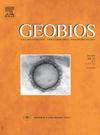晚更新世部分孔(Cuon alpinus europaeus (Bourguignat, 1868))的形态测定西班牙阿斯图里亚斯Llonin洞穴的食肉目,犬科)骨架及其地语学起源
IF 1.6
4区 地球科学
Q2 PALEONTOLOGY
引用次数: 0
摘要
本文介绍了在西班牙阿斯图里亚斯Llonin洞穴的三个晚更新世层(Cono后段)中发现的单个洞的遗迹。这些遗骸包括一个成年个体的部分骨骼,显示出小尺寸的牙齿,具有高度的高食肉性,具有从欧洲晚更新世衍生特征的典型种群。骨骼组合形态计量学分析显示其属于Cuon alpinus europaeus亚种(Bourguignat, 1868)。对整个骨头的直接测年提供了29,231±387 BP的日期,并确认了其考古地层位置与该遗址的格拉韦特时期有关。整个组合的地语学历史及其空间分布为这些犬科动物与史前人类群体的相互作用过程和洞穴占领动态提供了信息。本文章由计算机程序翻译,如有差异,请以英文原文为准。
Morphometry of a partial Late Pleistocene dhole (Cuon alpinus europaeus (Bourguignat, 1868); Carnivora, Canidae) skeleton from Llonin Cave (Asturias, Spain) and its taphonomic origin
In this paper, we present the remains of a single dhole discovered in three Late Pleistocene levels (Cono Posterior sector) of Llonin Cave, in Asturias (Spain). Said remains consist of the partial skeleton of an adult individual, showing small-sized dentition with a high degree of hypercarnivorism, typical of populations with derived traits from the Late Pleistocene in Europe. Morphometric analysis of the bone assemblage reveals that it belongs to the subspecies Cuon alpinus europaeus (Bourguignat, 1868). A direct dating on a dhole bone has provided a date of 29,231 ± 387 BP and confirms its archaeological stratigraphic position associated with the Gravettian phase of the site. The taphonomic history of the dhole assemblage and their spatial distribution provides information about the interaction processes and cave occupation dynamics by these canids and by prehistoric human groups.
求助全文
通过发布文献求助,成功后即可免费获取论文全文。
去求助
来源期刊

Geobios
地学-古生物学
CiteScore
3.30
自引率
6.20%
发文量
28
审稿时长
6-12 weeks
期刊介绍:
Geobios publishes bimonthly in English original peer-reviewed articles of international interest in any area of paleontology, paleobiology, paleoecology, paleobiogeography, (bio)stratigraphy and biogeochemistry. All taxonomic groups are treated, including microfossils, invertebrates, plants, vertebrates and ichnofossils.
Geobios welcomes descriptive papers based on original material (e.g. large Systematic Paleontology works), as well as more analytically and/or methodologically oriented papers, provided they offer strong and significant biochronological/biostratigraphical, paleobiogeographical, paleobiological and/or phylogenetic new insights and perspectices. A high priority level is given to synchronic and/or diachronic studies based on multi- or inter-disciplinary approaches mixing various fields of Earth and Life Sciences. Works based on extant data are also considered, provided they offer significant insights into geological-time studies.
 求助内容:
求助内容: 应助结果提醒方式:
应助结果提醒方式:


